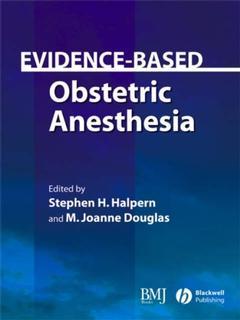Evidence-Based Obstetric Anesthesia Evidence-Based Medicine Series
Coordonnateurs : Halpern Stephen H., Douglas M. Joanne

Evidence-based practice is now being embraced worldwide as a requirement for all clinicians; in the everyday use of anesthesia and analgesia for childbirth, anesthetists will find this synthesis of the best evidence an invaluable resource to inform their practice.
Contributions from anesthetic specialists trained in the skills of systematic reviewing provide a comprehensive and practical guide to best practice in normal and caesarean section childbirth.
This book, coming from one of the world?s leading obstetric centers and the cradle of evidence-based medicine, is a much needed addition to the obstetric anesthesia literature.
Preface.
Acknowledgments.
Section 1: Analgesia for Normal Labor.
1 Consent for obstetric analgesia and anesthesia.
2 Epidural analgesia and the progress of labor.
3 Maintenance of epidural analgesia for labor—continuous infusion or patient controlled.
4 The use of transcutaneous electrical nerve stimulation for labor pain.
5 Is nitrous oxide an effective analgesic for labor? A qualitative systematic review.
6 Choice of local anesthetic for labor and delivery—bupivacaine, ropivacaine and levobupivacaine.
7 Intrathecal opioids in labor—do they increase the risk of fetal bradycardia?.
8 Epidural catheter design and the incidence of complications.
Section 2: Anesthesia for Cesarean Section.
9 The effect of increasing central blood volume to decrease the incidence of hypotension following spinal anesthesia for cesarean section.
10 The use of vasopressors for the prevention and treatment of hypotension secondary to regional anesthesia for cesarean section.
11 Is regional anesthesia safer than general anesthesia for cesarean section?.
12 Prevention and treatment of side-effects of neuraxial opioids.
13 Multimodal analgesia following cesarean section: use of non-steroidal anti- inflammatory drugs combined with neuraxial opioids.
Section 3: Complications of Obstetric Anesthesia.
14 The use of neuraxial anesthesia in parturients with thrombocytopenia: what is an adequate platelet count?.
15 A rational approach to aspiration prophylaxis.
16 Postdural puncture headache.
17 Epidural analgesia and back pain.
18 Analgesia for external cephalic version.
19 Is there a difference between the obstetric and non-obstetric airway?.
Appendix: Jadad scale for reporting randomized controlled trials.
Index
M Joanne Douglas, Clinical Professor, Department of Anaesthesia, University of British Columbia and British Columbia's Women's Hospital, Vancouver, BC, Canada
Date de parution : 08-2005
Ouvrage de 256 p.
19.3x25.4 cm
Thème d’Evidence-Based Obstetric Anesthesia :
Mots-clés :
anesthesia; first; systematically; evidence; text; review; obstetric; embraced; evidencebased; clinicians; practice; requirement; worldwide; childbirth; analgesia; use; everyday; invaluable; best; synthesis; anesthetists; resource; guide


